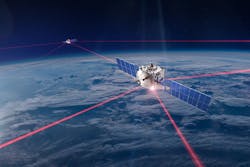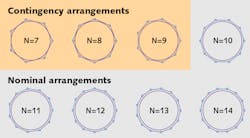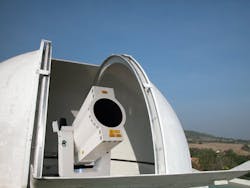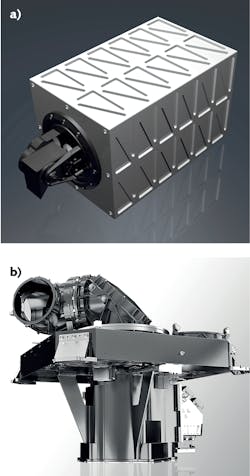Laser Links will link small satellites to Earth and each other
Three decades ago, the first long-haul submarine fiber-optic cables brought international telecommunications traffic that had been routed through geosynchronous satellites back to Earth by offering lower latency and more bandwidth. Now, planned constellations of small satellites in low-Earth orbit hope to bring telecommunications back to space by offering lower latency and more bandwidth to nearly half the world’s population who lack broadband Internet service. Laser links between those satellites will provide the backbone of the system (see Fig. 1).
The idea of laser communication in space dates back to the birth of the laser in 1960, when Theodore Maiman proposed it as a potential application. Yet not until 2008 was the first intersatellite laser link demonstrated between two low-Earth-orbit satellites, the European radar satellite TerraSAR-X and the U.S. military satellite Near Field Infrared Experiment (NFIRE), says Philipp Biller, product manager for laser communication systems at Tesat Spacecomm (Backnang, Germany). The laser terminals supplied by Tesat needed less than 25 seconds on average to lock onto each other and begin transmission in both directions at 5.6 Gbit/s. Test runs continued as long as the two spacecraft were in a line of sight from each other, an average of about 20 minutes during which the laser link between them turned about 80°. The experiments continued for several months, with bit error rates under 10-8 for ranges up to 8000 km.
NASA made headlines in 2013 by demonstrating the first laser link in deep space when its Lunar Laser Communication Demonstration (LLCD) transmitted data from the Moon at 622 Mbit/s. This marked a big improvement over data rates possible with radio waves.
The first commercial laser intersatellite link, Airbus’s SpaceDataHighway, began operation in 2016, using Tesat laser communications terminals to transmit high-priority image data collected by four satellites in low-Earth orbit at rates to 1.8 Gbit/s to relays in geosynchronous orbit for radio transmission to the ground. The high-speed laser uplink in the low satellite tracks the geosynchronous satellite so it can relay images quickly, without having to wait to pass over a ground station. Then, the synchronous orbit can relay the images to cloud servers on the ground via its high-speed microwave link. Addition of a second geosynchronous satellite in 2019 increased relay speed.
Meanwhile, a dramatic new vision has emerged for laser communications in space: using laser-linked satellites in low-Earth orbit to deliver broadband Internet and other services to places beyond the reach of fiber-optic cables. Two key factors have driven that trend, notes Tim Yarnall of the MIT Lincoln Laboratory (Lexington, MA). “SpaceX has disrupted the launch services industry, making access to low-Earth orbit much less expensive,” he says. “And a push to make small satellites has created a vendor base making all the things you need to build systems that would work in low-Earth orbit.”
Constellations of thousands of satellites
The idea is to orbit hundreds or thousands of small satellites 300 and 2000 km above the ground and make sure that at least one satellite is always in the sky above any point being served. The satellites would orbit around the Earth in a number of rings, spaced at different altitudes and positions to avoid collisions. Satellites would be evenly spaced around each ring so laser links would always have one or two adjacent satellites in sight (see Fig. 2). An individual ground station would connect to a satellite passing overhead to send signals, and when that satellite moves out of range, it would hand the connection off to the next satellite following its orbit. Once in space, the signal then would be routed through a series of intersatellite links until it reached a satellite passing over the destination, which would route the signal to a local ground station.Microwave links are likely between ground stations and satellites because clouds and precipitation can block optical signals in air. Some proposals envision microwave links between satellites. However, laser links offer important advantages over radio frequencies for intersatellite links above the atmosphere: higher transmission bandwidth, smaller receivers, and tighter beams to enhance security. The biggest challenge in the optical band is the need to sustain laser connections between adjacent satellites as the whole constellation moves through space and the nearest neighbors of each satellite keep changing.
The plan is a huge leap beyond the limited bandwidth of today’s satellite telephone systems, and has attracted wide attention from companies hoping to deliver broadband services to large areas poorly served by existing cables, including much of Africa, central Asia, the Arctic, and the rural central United States. Facebook early on proposed transmitting from high-flying drones, but is now considering satellites. Google’s Project Loon flies balloons at altitudes of 18 to 25 km, and has a contract with Telkom Kenya to provide services in rural areas. Fleets of hundreds or thousands of low-orbit satellites could serve much broader areas, and would have much lower latency than the quarter-second round-trip time to geosynchronous orbit.
Amazon, Boeing, and SpaceX all have announced plans for thousands of small low-orbit satellites, and Facebook is also interested. In early May 2019, Aviation Week counted proposals from 32 companies for a total of 13,529 small communications satellites in low-Earth orbit. Only a few test satellites were in orbit then, but on May 23, 2019, a single SpaceX launched 60 test satellites for its Starlink system; three subsequent launches have added more satellites. The satellites lacked laser transmitters planned for the full system, but had internal engines that raised them from the drop-off point at 440 km to final orbits at 550 km. Much more is in the offing—SpaceX is now talking about adding some-7500 satellites to the 4400 it originally planned, which would the bring the Starlink constellation close to 12,000 satellites.
Laser hardware
Radio-frequency transmission is less expensive, but lasers can offer more bandwidth for a modest premium. That has led laser developers to focus on 10 Gbit data rates so they can exceed the data rates available with microwaves.
The planned intersatellite laser links are largely based on technology developed for ground-based fiber-optic systems. Almost all transmitters in development are based on distributed-feedback diode lasers followed by fiber amplifiers, says Tim Yarnall of the MIT Lincoln Laboratory. Both the 1550 nm erbium band and the 1030–1080 nm ytterbium band are under consideration. “You can buy lots of good parts at 1550 nm,” he says, but “power is easier to generate at one micrometer.” Tesat uses 1064 nm diode-pumped solid-state lasers for its long-distance relays to geosynchronous orbit. A standards group, the Consultative Committee on Space Data Systems, recently recommended using 1550 nm for downlinks from orbit and 1 µm for uplinks to keep wavelengths separated. However, the technology is still evolving.
A 7–15 kg terminal could transmit 10 Gbit/s on a 4500 km intersatellite link, says Paul Cornwell of Mynaric, AG (Gilching, Germany), a company founded a decade ago to develop wireless laser links for aerospace use. “The future is terabit speeds,” he says. The company is looking at 100 Gbit/s, but its current products operate at 10 Gbit/s. Figure 3 shows a Mynaric ground-based laser terminal.“Pointing, acquisition, and tracking is the most challenging problem in space laser communications,” says Yarnall. A fundamental tradeoff is directivity vs. power—the tighter the beam divergence, the higher the power on target, but the more demanding are the requirements on directivity. Laser divergence can be as narrow as 10 µrad. “That may be worth it for the NASA [deep space] programs we support,” he says. “Size, weight, and power are the key concerns, so they let us use very complex pointing control systems to get every last bit out of performance rather than spraying power in all directions.”
The economics are very different for constellations of hundreds or thousands of satellites in low-Earth orbit, where orbits decay within a few years, so satellites have to be replaced frequently. To control costs, satellites must be small, mass-produced, and mass-launched. Yet, they also must be sophisticated enough to keep their transmitters properly aligned to communicate with their neighbors in orbit, and the system must be resilient enough to keep on working or recover quickly after a single satellite fails.
It adds up to a tough set of requirements. The general consensus seems to be that the planned constellations need to be based on “smallsats” weighing up to 500 kg. That’s just under one-tenth the 5300 kg for the geosynchronous satellites in the EuropeanDataHighway, small enough that several can be launched on a single rocket to reduce costs. SpaceX’s Starlink satellites will weigh in at 227 kg and will carry four relay links, two to the satellites ahead and behind it in orbit, and two others linked to the nearest satellites in other orbits. With each laser terminal expected to weigh 7 to 15 kg, they would account for 30 to 60 kg—an eighth to a quarter of the total satellite. Power, pointing and tracking, control systems, propulsion, and other equipment would account for the balance.
Most architectures call for radio-frequency downlinks from low-Earth orbits to ground stations because radio can deliver signals through clouds and precipitation that make laser downlinks unreliable. Tesat is an exception, offering a Tosiris laser downlink that can transmit up to 10 Gbit/s to ground stations with uplink beacons to aid in locking onto the receiver. To deal with weather, Biller says they install several ground stations over the area where the signal is to be delivered and have the system select the site with the clearest air to receive the signal. The system is designed to download satellite information, so it requires only several megabits per second for uplinks, which also are delivered via laser. Figure 4 compares Tesat laser transmitters for low-orbit to ground and between geosynchronous satellites.Cubesat communications
Satellites assembled from modules 10 by 10 by 10 cm called “cubesats” have been in the spotlight because they offer inexpensive access to space for projects such as laser guide star research. They are also being tested for communications. Kerri Cahoy’s group at the MIT Space Telecommunications, Astronomy, and Radiation Laboratory has also developed tools to optimize pointing laser beams from cubesats, reducing beacon tracking errors to an average of 16 µrad. Tesat has delivered a 360 g, 9.5 × 9.5 × 3.25 cm laser communications terminal capable of transmitting 100 Mbit/s from low-Earth orbit to the ground to an unidentified U.S. customer.
However, the small size of cubesats limits their usefulness in constellations. “Cubesats are notoriously shy on power,” says Yarnall, a limit on designing transmitters and control systems to link to other satellites in the constellation. Biller thinks cubesats’ communications can work for Earth observation or Internet of Things (IoT) links at low data rates, but that larger “smallsats” are needed for constellations.
Plans and outlook
Details of some major plans remain vague. Boeing has filed plans for a constellation of some-3000 low-Earth-orbit communication satellites with the Federal Communications Commission, and has invested in Bridgecomm (Denver, CO), a maker of laser communication equipment for ground stations and low-orbit satellites operating in the 1550 nm band. Amazon has filed plans for a fleet of 3,236 satellites called Project Kuiper Systems LLC that would orbit satellites at 590, 610, and 630 km to serve the 95% of the world’s population living at latitudes up to 56° from the equator. But few other details are available about either big constellations. Many other companies also are working quietly on plans for building equipment or launching laser-linked satellites.
Other plans do not involve lasers. OneWeb (McLean, VA) plans a constellation of 588 low-Earth-orbit satellites—49 in each of 18 orbital planes—that will connect end users through the satellites to ground-based gateways via microwaves, with no intersatellite connections. OneWeb launched six test satellites on July 16, 2019, and planned to launch over 30 more in December 2019, with more launches following regularly.
Worried that military communications and operations depend too heavily on large and vulnerable geosynchronous satellites, DARPA’s Blackjack program is developing plans for a global high-speed network in low-Earth orbit. The goal is a more flexible and resilient system that could take advantage of commercial technology and would not depend on a few tempting targets in geosynchronous orbit.
The first generation of commercial laser communications terminals for low-Earth-orbit satellites are in development. “Timetables are difficult,” says Cornwell, but Mynaric hopes to complete qualification of its 10 Gbit/s laser terminals before April 2020 and begin production later in the year. Tesat plans to test its 10 Gbit/s Tosiris satellite terminal on the International Space Station in 2020. Real hardware should soon be rolling off production lines. Tomorrow’s 5G networks could use the capacity.
It’s hard to believe that all of the roughly 20,000 planned satellites will be launched. On the other hand, if they all operate at 10 Gbit/s and each one transmits a single channel, the overall capacity is on the order of 200 Tbit/s. That’s only about 35% larger than the 144 Tbit/s capacity of all six fiber pairs in the Pacific Light Cable, currently the world’s highest for a single cable. It’s no wonder that Cornwell says “the future is terabit speeds.”

Jeff Hecht | Contributing Editor
Jeff Hecht is a regular contributing editor to Laser Focus World and has been covering the laser industry for 35 years. A prolific book author, Jeff's published works include “Understanding Fiber Optics,” “Understanding Lasers,” “The Laser Guidebook,” and “Beam Weapons: The Next Arms Race.” He also has written books on the histories of lasers and fiber optics, including “City of Light: The Story of Fiber Optics,” and “Beam: The Race to Make the Laser.” Find out more at jeffhecht.com.



